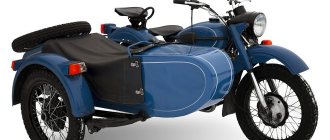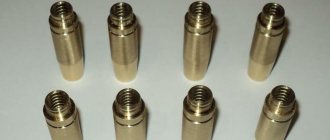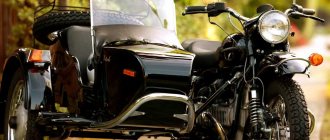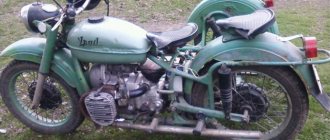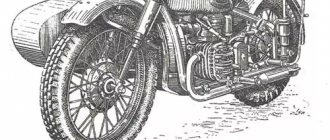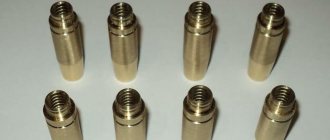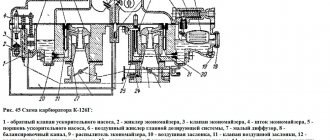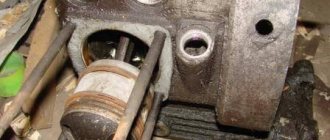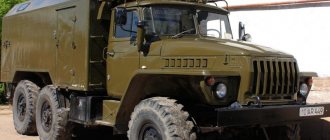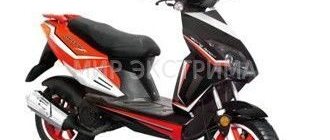Welcome to our custom parts workshop and our online store for the Ural motorcycle. On the Internet you will find many sites that sell a wide variety of products for the Ural motorcycle. However, not all of them do tuning for motorcycles and even fewer specialize in customization. Basically, they sell motorcycle spare parts.
Workshop of custom parts for tuning the Ural motorcycle
Nobody disputes that this is a necessary market segment. If you were looking for an online store for the Ural motorcycle specifically to find a spare part, do not rush to leave this page. You may be interested in our offer.
Our online store specializes in the production of custom parts for tuning Ural, Dnepr and K-750 motorcycles. Of course, this is not the only direction of our activity. We are a custom parts workshop and make custom valve covers for the Urals. And also equally stylish gas tank caps for motorcycles of other brands.
Additional engine modifications
In addition to the above methods of tuning a Ural motorcycle, there are several more secrets.
It is possible to install a crankshaft from the K 750 on the Ural engine, which will increase the cylinder stroke to 78mm. Thus, it is possible to significantly increase the working volume of the Ural engine. It's quite difficult to find, but it's worth it. Another problem with the motorcycle is the tight response to the throttle and slow acceleration. The reason for this is that the flywheel is too heavy, the weight of which is designed for riding with a stroller and for transporting heavy objects.
According to the drawing, it is possible to reduce its weight by a couple of kilograms. Due to the weight reduction, the inertia of the crankshaft will decrease, and the acceleration dynamics will significantly increase. To fully realize the power on the road, the gears of the gearbox must be replaced with 9 or 10 pairs. In conclusion, we would like to note that tuning the Ural motorcycle engine is justified only for racing purposes; for everyday use, such an engine will have a short resource and significant fuel consumption.
“Ural” is one of the most recognizable Soviet motorcycles. The model is a copy of the BMW R71. During Soviet times, the Ural was used by the Ministry of Defense for patrol purposes. Combat models equipped with a machine gun or launcher carrier were also produced.
The motorcycle has a 750 cm3 engine with a power of 40 horsepower. The weight of the Ural exceeds 200 kg, but despite this it quickly picks up speed. The brakes are hydraulically actuated and located on the spoke of the rear wheel. The shape of the fuel tank, lights and turn signals are designed in a militaristic style, which especially pleases fans of this motorcycle.
Modern versions of the bike are designed for riding in urban conditions and combine power and reliability. The seats are trimmed with genuine leather, which gives the motorcycle a special chic. Manufacturers strive to maintain a retro style when creating modern models.
"Ural" is valued for its retro style and modern filling. The history of the motorcycle goes back more than 60 years, and all this time motorcyclists have been trying to improve the appearance and technical performance of the motorcycle. The price for this “iron horse” is quite high, but there are fans who are ready to buy this model.
An improved Ural is almost impossible to buy. Fans who have invested a lot of time and effort into their motorcycle are not inclined to sell it. So if you want to get an improved Ural, you will have to do the tuning yourself.
The main “wolf” highlights
When designing the model, true connoisseurs of motor vehicles equipped the Ural Wolf with an extended base. It allows the chopper to spread its motorcycle delights from the front to the rear axle, as much as 1.69 meters.
The work of the “heart” is carried out by a powerful forty-horsepower engine with a capacity of 745 cm3. Two cylinders make it possible to take off and reach a speed of 100 kilometers in literally ten seconds, and if you get a good run, then one hundred and fifty kilometers on the speedometer needle will pleasantly please the owner of this wonderful bike.
Adding pleasant moments is the relatively low fuel consumption - approximately 5.5 liters per hundred kilometers. The ideal gas station for the Wolf photo is ninety-second gasoline.
Dynamics and good maneuverability are achieved due to the Italian steering assembly , which contains conical roller bearings. A microprocessor in the Ducati ignition, Yuasa batteries and a 500-watt Denso generator complement the twin speedometer, which has speed indicators of miles and kilometers traveled.
The crankshaft, as rigid as an irreconcilable biker’s heart, will help you find out the true capabilities of Wolf, which does not change its operating mode, even after crossing the sixty-thousandth mileage line.
The characteristics of the Ural Wolf are complemented by an improved gearbox with four stages. The valuable feature is that the fourth stage is “direct”. When the speed of the chopper approaches the 150-kilometer speed mark, it does not allow the engine to “spin.”
Speaking of suspensions, you can also feel the skillful hand of a biker , firmly holding the steering wheel of his motorcycle while traveling on the roads of Russia. The chopper is adapted to the characteristics of domestic roads, which makes the owners incredibly happy. The proposed speed of any route will not detract from the charm of the ride thanks to the remarkable shock absorption.
Due to this circumstance, the motorcycle has a combined brake: hydraulic disc brakes from Brembo at the front, and mechanically driven drum pads at the rear.
Of course, we should not forget about the external appearance of this brutal model, the design of which did not deviate from the already recognized and beloved American motifs. During assembly, a play of colors and chrome finishing .
Exterior
According to the performance characteristics of the Ural-4320, it is equipped with a metal platform body and a tailgate. The car is equipped with benches, an awning and removable arches. There are also additional lattice sides. The standard equipment includes a three-seat cabin, assembled from thick-walled sheet metal, manufactured by stamping. Thoughtful glazing and rear-view mirrors make it possible to fully monitor the situation on the road and increase visibility.
Structurally, the body is made in the form of short overhangs, which improves cross-country ability. The curb weight of the truck is 8.2 tons. The weight of the transported cargo is up to 67.8 tons with the ability to tow 11 tons.
Do-it-yourself Ural motorcycle tuning
If you own a Ural motorcycle, but its appearance does not suit you, and you constantly look at foreign handsome men, do not despair. You can improve your vehicle. Most often, they buy a domestic motorcycle just for the shell, and everything else is redone.
Before you get started, check out all the proposed upgrades and photos of motorcycles on the Internet.
Having decided, you can begin work. First we redo the rear part of the frame.
- The pendulum needs to be expanded.
- Cut off the seat tubes.
- We weld curved pipes with a diameter of 28 mm, no less. This is not only a beautiful decor, it is also a headscarf amplifier.
- To make the suspension softer, the rear shock absorbers need to be installed at an angle.
- When you put the wide rear wheel in place, make sure that the rubber coupling works without distortion.
- The footrests need to be moved forward, it will be more comfortable for your legs.
- The frame needs to be lengthened by ten centimeters.
- The engine moves backwards.
Perhaps in this case the landing will be incorrect. But for every motorist it is different, individual.
After completing all the work, select a workpiece, perhaps from a stroller, for the rear wing. If you want it to be deeper, you can cut plates from it and butt weld it to the wing.
Let's start working on the tank:
- Use a grinder to remove the glove compartment.
- You also remove the neck and tunnel.
- A wedge is used to cut the top of the tank.
- The two halves are welded at the back. And the neck and tunnel are welded.
- To keep everything sealed, use epoxy resin.
Now we work with the seat:
- You need to cut the base from two-millimeter steel.
- Place thin foam rubber under it.
- The finished structure can be covered with either suede or leather.
The steering wheel needs to be made simple. Everything is cut from a single piece of metal. This is the handle, clutch lever, brakes. For the mirror stand, cut blanks from eight-mm steel. You can buy a housing for a mirror in a store or make it yourself in the form of a sphere.
Silencers are located on the right side.
- Weld the left exhaust pipe without bending it.
- The right pipe remains standard, but it needs to be shortened a little at the top so that the leg does not melt.
- The seams are cleaned, polished and chrome plated.
- To get a chopper sound, you can insert valve springs from a car into the mufflers.
Ignition
Following an increase in power and replacement of pistons, it is advisable to replace the spark plugs. Spark plugs A20 DV and A17 DV from Zhiguli are suitable for Ural. Some craftsmen install an additional candle. This increases engine power at high speeds, reduces consumption and can become a replacement for boost. But work will have to be done to develop an independent spark generation system. At the same time, the air filter is changed, which reduces friction losses during intake.
If the engine is old, then it is advisable to replace the carburetor and install an injector. This can be done with your own hands or with some help. Tuning the Ural motorcycle can be done using injection spare parts from the VAZ "Ten"
At the same time a new starter is installed. Starters from the Vikhr outboard motors ST 353, ST 367, ST 369 are suitable for IM3. VAZ motors - from models 9, 10 and 11 - are also successfully built in place of the originals.
On the subject: How to delete music from an iPhone via iTunes: instructions and recommendations
Specifications
Let's do a full analysis of technical data based on one of the first models - Ural M-62.
Ural M-62
The heavy Soviet motorcycle was equipped with a four-stroke carburetor two-cylinder engine with opposed cylinders and air cooling:
- working volume – 649 cubic meters. cm;
- cylinder diameter – 78 mm;
- piston stroke – 78 mm;
- compression ratio – 6.2;
- maximum power – 28 hp. s., 20.6 kW;
- crankshaft rotation speed at maximum power – 5,000-5,200 rpm;
- maximum torque – 47 Nm;
- carburetor - K-38;
- air cleaner – combined inertial contact-oil filter with two-stage cleaning.
Transmission:
- clutch: dry double-disc, driven discs with linings on both sides;
- cardan transmission: cardan shaft with an elastic coupling and a hinge on needle bearings;
- main gear: a pair of bevel wheels with spiral teeth, gear ratio - 4.62;
- gearbox: four-speed, with gear ratios in 1st, 2nd, 3rd, 4th gears 3.6, 2.28, 1.7, 1.3, respectively.
Electrical equipment:
- ignition system - battery;
- voltage – 6 V;
- battery – ZMT-12;
- generator – G-414;
- relay-regulator – PP-31;
- breaker-distributor – PM05;
- ignition coil - B201.
Chassis:
- frame – tubular double closed type;
- Front wheel suspension – telescopic fork with double-acting hydraulic shock absorbers;
- rear wheel suspension – spring;
- front wheel travel – 80 mm;
- rear wheel travel – 60 mm;
- tire size - 3.75-19 inches;
- brakes are shoe brakes, with friction linings on the front and rear wheels.
Refueling volumes:
- fuel tank – 22 l;
- engine crankcase – 2 l;
- gearbox housing – 0.8 l;
- final drive housing – 0.15 l;
- air purifier – 0.2 l.
Dimensions:
- length – 2,420 mm;
- width – 1,650 mm;
- height – 1,100 mm;
- motorcycle base – 1,100 mm;
- ground clearance at full load and normal tire pressure – 125 mm;
- track – 1,130 mm;
- maximum speed – 95 km/h;
- weight – 340 kg;
- maximum load – 255 kg;
- average operating fuel consumption per 100 km when driving in various road conditions with variable load is 6 liters.
solo 750
I decided to write for the story of how I assembled my second solo. I collected the first solyak a long time ago, here is the link: I drove about 25,000 km on it, sold it to a good person, and it still drives to this day. A year passed and I wanted to put together Solyak again, only with additions, with what was missing in the first one. The budget, of course, amounted to 3 budgets for assembling the first one (everyone knows the prices for spare parts).
Frame
Solo frame 1993, without a side stand, but with its fastening (I bought the footrest from Voyage, adjustable, fit 1 in 1)
Someone cut off the fastenings of the central step, I had to cut off the ears from the Economic Council and weld them back into place. There is also a rubber bumper for folding the central assembly.
the fork assembled in front from Orion. I completely rebuilt the feathers, new oil seals, new oil, corrugations, made drainage underneath for easy draining of oil without removing the fork. Installed tapered bearings in the steering column, machined out boots for them. Photo of the kit I bought.
I reassembled the front wheel and installed a new 36-spoke rim.
the pendulum here on the forum, with needle bearings already installed, the included working bushings were damp, I had to go look for pins from the brand. In the end, I lubricated everything, assembled it, and it works great.
Rear brakes It was decided not to build a collective farm, but to assemble a more or less stock version. I spent several evenings poring over catalogs in order to understand what the Brembo calipers and brake discs of the new Jirappa model were installed on. All in order to save money, because these parts are very new. expensive.
I bought the caliper at a disassembly site from a liter Aprilia
I also ordered a brake hose, M10x1 caliper bolts, and pads
From Wolf brackets I made brackets with the dimensions I needed.
The pin is machined and pressed into the pendulum
A new hub was purchased for the HTD, and the wheel was assembled on it. This hub has some advantages - maintenance-free bearings, replaceable spline.
rear machine assembly from SB 600
Rear brake disc 1in1 with ours is a '94 VFR 750. Thanks to NG catalogs.
Result
Front brake caliper remains Orion. new brackets, rubber pads. The hose is also Orion, the machine is from a Ducati monster, I took it apart, sanded it and put it back together. As a result, the car decides, the Orion caliper brakes adequately.
wheel Catalog steering wheel , ordered. Made by Lucas/Trw, high quality, stamped serial number. Remotes. Good quality. Metal case, wires and contacts are all soldered. Very comfortable, the positions are fixed in order. I also ordered grips, they are comfortable and soft.
I also ordered metal vibration dampers for the steering wheel.
Domino cable splitter, made from Honda cable specifically for my right remote control, and then for K68, 3 cables. The photo shows a temporary test remote.
Fitting
Since the car did not have a frog brake light, I ordered a convenient thing. I think they call it hydraulic contact. In general, everything fits and works.
Electrics A starter was planned for the motorcycle, and I also wanted to connect the main consumers through a relay. I ordered a convenient block for fuses and relays. True, I had to look for one relay, because the location of the legs was different for it. Found it from Toyota in a local Jdm club)
Next I ordered a set of chips, compact and convenient. And the remote controls with the frog came just for these connectors. Compact RR. Order number in photo. yes, yes, I prepared the circuit specifically for g424. (denso will come later)
I installed relays from BMW into the block, as well as some connecting bars and wires.
The battery ordered a 14A 12V starter. I selected the size based on the remaining space in the standard niche. I used the starter all season, never had to recharge it, no losses, 424 gen. That's it.
Exhaust Cans, clamps, extensions are all new. The knees are in excellent condition from the wolf. No matter what anyone says, I couldn’t get knees from 650 to 750. Maybe they’re collective farmers somehow, but I didn’t.
tank New solo tank. new nigrips with the Eames logo, and an elastic band.
The seat is just new from Patrol
Gearbox Stock gearbox 9ka with solo, factory assembled. I removed the drum mechanisms and plugged the hole for the rod. changed the seal. Engine Purchased 750 ss. 2000. Factory assembled. for piston repair. This is how he came to me. Well, overall I just went through the entire engine, nothing special. Imported seals, bearings, timing gears with clearance according to the book. gaskets, rubber bands, fingers, everything new from the machine shop. as well as new cylinders.
oil drain plug with magnet
Max sent excellent clopon
A box with voyage bearings Fag, oil seals Payen, put a new secondary shaft for installation of elastic, and machined the secondary shaft fork for installation of an imported oil seal.
strater new
new mid-spline cardan
A copy of the starter cover was made using a 3D printer.
Assembly photo
There were still many photographs that could not be saved. New documents, Ural, black, 750cc, 2007, frame number, internal combustion engine. The nameplate is all in place.
In general something like this
I drove about 5000 km over the summer. In the city the consumption is about 6 liters, on the highway 5.5 per 100. I won’t remember much right away, I’ll add information as I go. Many thanks to everyone who helped with advice or from whom I bought parts.
Weaknesses of the IMZ-8.103-10 (IMZ-8.103-30, M-67-36) engine of the Ural motorcycle
- Foot starter (kickstarter);
- Gas and clutch cables;
- Generator;
- Carburetors;
- Cylinder heads;
- Reverse gear (gearbox).
More details about the weak points of the motor...
The foot starter of the IMZ-8.103-10 engine is a weak point due to the slippage of the pawl. The malfunction is eliminated after dismantling the gearbox and disassembling it with rearranging the pawl with the other side or replacing it. I have an assumption that the metal of the dog is of low hardness. On the other hand, if the pawl is made harder, the gear will fail. You need to choose the golden mean.
The clutch control and fuel supply cables are a weak point due to their short service life. To put it simply, they tear, and before that they stretch, which makes it necessary to adjust the timing of the supply of the fuel mixture, as well as the clutch.
The generator does not run for a long time.
Gasoline gets into the floats, after which the cylinder is filled with gasoline. In addition, carburetors are not matched to these engines; half of the fuel goes to waste, which is not economical. It would be nice if the engine had one carburetor instead of two.
Do not overtighten the spark plug heads; the threads break off quite easily. You cannot overheat the engine, the result will be clearly visible on the heads, the studs are pulled out, leading to the landing plane of the heads. If you are unable to avoid breaking the spark plug thread, contact a familiar turner; he will be happy to repair it and install a steel threaded bushing for a modest fee. I can recommend the same for wear of valve seats and chamfers. It is much cheaper to repair heads than to buy new ones; a good turner can do this in no time.
The reverse gear does not work for a long time due to the rapid wear of the reverse gear in the gearbox.
Opposed nishtyaks and IMZ spare parts.
Selling boxer cars and spare parts. Not all items are on sale. If you are looking for something, find out in l.s. Hydraulic damper bracket for traverses up to 2013. A proven damper can be ordered for RUB 1,800. kit for adapting Japanese carburetors for internal combustion engines 750cc and 650. Stainless steel adapters 1800 rub. Clamps 160 rub. Stainless steel hexagon socket screws 100 rub. Silicone pipes 250 RUR Rubber pipes 150 RUR. Gaskets for 650 motor 50₽ Gaskets for 750cc 200rub. Timing cover of a new model for a carburetor engine RUB 10,000. Sidecar fender with lamp brackets for the drive frame. New. 7000 rub.
KOK manifolds for 750cc heads. 1500 rub. Domino remotes with light switch on the right remote. As in the photo, only silver. 13000 rub. Front fender of telescopic fork. New from storage. 1500 rub.
Crankshaft support 750cc front 1600rub. The protection (visor) for the steering column wiring is metal. Stainless steel 650 rub. For painting 350 rub. Powder painted 450 rub. Exhaust pipe flanges for new 750cc heads. (stainless steel) 900 rub. Gasoline hose Gates d8mm. Which does not become limp from gasoline and does not clog carburetors. 1 meter 400 rub.
Bracket for additional light on the stroller arch. 1500 rub. 750cc Crankshaft Rear Bearing Retaining Rings. 120 rub. Retaining ring DIN 471 40×1.75 Retaining ring DIN 472 80×2.5
Splined flange. Catalog number IMZ-8.1037-07105-10. 1500 rub.
Drive spline bushing. Catalog number IMZ-8.128-05516-10. New 1800 rub. Candle holders made in the USSR 150 rub/pair. High-voltage wire 150 rub/meter.
Bracket for rear disc brake of a new type. 4000 rub.
Set of frame bridge with bracket for a “frog” saddle RUB 4,000. Rear caliper bracket Solo ST. For a Brembo caliper or an analogue from an alishka and a brake disc d255mm. 2300 rub.
Saddle bracket (frog) assembled. Catalog number IMZ-8.103-09022-01. Matte black or gloss. 2800 rub. Painted complete with frame bridge 4000 RUR. Decals URAL size 110mm x 23mm. Fits the dimensions of the original tank nameplates. Black vinyl 100 RUR/2 pcs. White on reflective film. 200 rub./2pcs. Ural motorcycle frame bridge, for installation of a solid saddle or frog, catalog number IMZ-8.1037-09200-01.1700rub. Set of gaskets for internal combustion engine 650 paronit. 200 rub.
Head gasket. 120rub/piece
Spacers 1mm. and 2mm. are adjustable, used as necessary to adjust the position of the starter ring gear. Catalog number IMZ-8.124-18113. 1mm/250rub., 2mm/300rub.
Chrome front rim 18 Ural Wolf with 36 spokes. 4000 rub. There are no spokes or hubs!
USSR instrument panel eyes new in assortment 120rub/piece.
Plastic mudguard 80 rub. Tires 350 rub.
Used spare parts
Front fenders with telescopic forks, 500 rub.
Oil pump 700 rub. Rod casings 800 rub. Bracket with lantern 300 rub. Air filter cover chrome 500rub.
Gas tank in factory paint. Nigrep fastenings are cut off. 1000 rub.
It is possible to send to any point at the buyer’s expense by Russian Post only the spare parts that will be included in the postal package. (I do not send cash on delivery due to the frequent refusal of parcels!) or transport company preference PEC, Business Lines, GTD, SDEK. After 100% payment to the Sberbank card. Detailed photos upon request by email, Viber, WhatsApp or contact. For a quick response, it is advisable to immediately write to Viber.
Tyumen tel. 89199560000 Vladimir. Viber. WhatsApp +79199560000 e-mail. in contact with. https://vk.com/vladimir_akela my group in contact https://vk.com/imzmotoparts
Ural's position now
Before the notorious events of the early nineties, about three million devices were produced. After the collapse of the Union, the plant's position began to deteriorate. The purchasing power of the population fell sharply, factories in the country were closed and sold off. Fortunately, the unenviable fate passed the Ural. Production continued. These were mainly motorcycles with a sidecar (with or without a drive), with a 4-stroke opposed two-cylinder engine with a volume of 745 “cubes” and a power of 40 “horses”, plus 4 gears and reverse gear.
Since the mid-90s, almost all parts in the design of the Ural motorcycle have been improved or replaced with new ones. In honor of the 70th anniversary of the plant in Irbit, modernized models were produced, one of the best is the Ural motorcycle with M70 Sidecar tuning.
The sale of models already produced in Russia, and not in the USSR, is aimed at foreign countries. 97% of all models of the plant are sold in the USA, Europe, Canada, and Australia. Asia is considered as one of the promising markets: Japan and Korea. In these countries there are simply no competitors in the niche of motorcycles with sidecars, but there is demand. China, as a sales market, has been producing a replica of the M-72 under the guise of a copy of BMW since the 50s.
Ural Voyage
Filmoscopes:
I’ll add information on Voyages... As usual, I inform you that all the information I have is based on rumors and should not be considered as the truth in the first instance. More than 25 years have passed since then, and many eyewitness memories may not be entirely accurate. For the correctness of the topic on a specific model, it is worth pointing out that the main designer of the Voyage project was Alexander Strokin and the main designer was Viktor Shevchenko. It’s also worth placing this sketch in the main post. This drawing by the chief designer is dated June 16, 1995.
The first Voyages can be identified by the number on the gearbox...type 00001, etc., and not by the engine number, as you might think. Of course, the number on the Voyazhevsky engine 720 or 750 means the serial number of production of these particular engines and not the motorcycle as a whole. Most likely, the so-called starter gearboxes came from Voyage. The first voyages had a front brake lever from IZH. Later, a homemade design appeared. (in the photo the brake machine from IZH is on the Cobra. I haven’t found the right photo yet)
The gas tanks on the first Voyages were hand-made and, of course, with a regular cap. There is information that, among other things, one of the gas tanks had chrome plated cheeks, like on old Javas or, for example, Pannonias. (Such tanks were made as a special order for various Ural models.) The first batch of motorcycles of 6 pieces was the so-called gift one. It’s not that they were all given away, no. Some were used for exhibitions and various presentations, and some were actually donated. On these motorcycles, the painting on gas tanks and battery compartment covers was done personally by Viktor Shevchenko. Basically it was the so-called “kitty”, but the museum has a Voyage with a different design. Later, the cat's face was painted on gas tanks by factory painters using stencils! They say the picture quality was no longer so great. I don’t know how many Voyage gas tanks were painted and what variants of the designs there were. I think only Viktor Shevchenko himself can answer this question.
How many times have I walked past a motorcycle in the Irbit Museum, and only recently saw these nuances in the drawings... There is a legend that this tank was in V. Shevchenko’s office, and later he gave it to the museum. There it was installed on a museum specimen. There is also a legend that he depicted himself in the drawing..
With the rear wheels the picture is not entirely clear. The wheels on the first motorcycles were of two types. Some were spoked and had a 16″ rim. The brake drum was of the M-72 plate type. The second ones had solid milled aluminum. 15″ wheel also for drum brake. Which of them should be considered the very first is not clear. It is also not known how many wheels were produced.
I have this photo. According to knowledgeable people, this is probably the next batch, after the first 6 pieces. According to them, the first motorcycles had 16″ spoked rear wheels, which had a plate drum like the M-72. But the second 6 pieces seemed to already have solid milled aluminum. 15″ wheels
ps I will answer the question from this topic. What was once written in Moto magazine should be considered basic information. The chances that some additional, more accurate information on this model will appear are very small. There is simply no one to collect it and somehow publish it. True, there is still a theoretical opportunity to talk about this topic with the creators of the motorcycle.....
Painless changes
You should not assume that any painless tuning for a Ural motorcycle will be easy to do. But, as they say, hunting is worse than bondage. For clarity, we will divide possible alterations into external and internal. The external ones are aimed at correcting the veteran’s appearance, while the internal ones will affect his driving performance and technical characteristics.
Appearance correction
Classic shapes, characteristic of all models without changing, go well with an abundance of chrome parts. Since chromium has good anti-corrosion resistance, it is not forbidden to use it even in the most unexpected places. After this processing, many details will look good:
- Front and rear wings.
- Fuel tank.
- Side panels.
- Engine crankcase, cylinders and cylinder heads.
- Frame and suspension elements.
But if there is no opportunity or desire to do chrome plating, high-quality painting of a Ural motorcycle can be an alternative. There will be room to turn around, especially if you have a modification with a stroller.
Good results can be achieved by installing wings of a different style and size, a different fuel tank, roll bars and even optics. Many favorite modifications - installing a high steering wheel and new control handles, altering the seat, without the right approach, worsen the rider's position, making it less comfortable
Such changes should be made with caution
Inner harmony
Many owners start tuning the Urals to improve the technical characteristics of the motorcycle. Despite some orthodoxy in the design of the engine and gearbox, there is room for improvement here. The following steps can be taken:
- Installation of crankshaft (crank) support bearings, the quality of which is better than standard ones. It is not recommended to reduce the size of the support necks themselves. After all, this removes the heat-treated layer and reduces the strength of the critical elements.
- Reduced weight of pistons and connecting rods. Excess mass of these parts leads to an increase in the moment of inertia and a decrease in engine power. Even simply by removing the casting flash, you can significantly reduce the weight and increase the effective output of the power unit.
- Alignment and grinding of inlet and outlet channels. Grinding in valves. Such procedures will improve the filling of the cylinders with the combustible mixture.
- Manufacturing a new camshaft with a different cam profile, allowing the valve timing to be changed. This is a complex engine tuning that requires special knowledge.
- Installation of new carburetors. A well-proven measure that allows you to get rid of failure during acceleration, which is characteristic of all IMZ models without exception.
This is due to the fact that the manufacturer equips the equipment with variable-discharge carburetors, which are poorly suited for four-stroke motorcycle engines. You can get rid of this by equipping the motorcycle with suitable constant-vacuum carburetors. Both Mikuni and Keihin have such models. To optimize operation, the flow area of the nozzles will need to be adjusted. Ideally, such modifications are carried out on a special stand. In the absence of one, one has to be content with fitting in road conditions. After such engine modernization, the Ural will accelerate much more confidently. - Replacing standard air filters with others that have similar throughput but less resistance.
- Installation of inertial boost. This will only work if you purchase components from a reputable manufacturer. There are often low-quality or even non-functional components on the market.
- Manufacturing of new gearbox gears. Despite the relative labor intensity, this motorcycle tuning is more than justified. Original gears are often not of high quality and not only make it difficult to change gears, but also make noise during operation.
- Installation of alloy wheels. Such modernization is not always justified. A cast wheel, if it is not spoked, will look ridiculous on a classic.
Whether you make all the upgrades, or just some, in any case, tuning the Ural motorcycle engine will be completely justified.
Motorcycle IMZ Ural Wolf 1999 review
The sensation of the season is “Ural Wolf”! A device that is not embarrassing to ride is an exceptional and joyful occasion for our motorcycle industry. After all, they can whenever they want! We saw a well-tailored chopper with an updated boxer engine (they even promise to make it with an acceptable level of quality and reliability). The most shocking thing is that the well-tailored “Wolf” was developed on the basis of... the bastard “Cobra” (opinion not mine - the motorcycle people)! But this car is already without the minus sign; two cars were shown at the Third Moscow International Exhibition “Motorcycles, Yachts and Scooters '99”. One is standard, prepared for serial production. The second is from the specialists of the Wolf Engineering studio, who not only designed (and to the point!) the constructors of the “basis”, but also tuned it - no matter how little it seems! We especially advise you to pay attention to the exhaust system and the seat of the device. It’s really nicer than the “base”, isn’t it?
The Ural men do not sleep. The period during which the “Wolf” was created, elapsed from the moment the general director spoke with the designers until the production of the first copies, is a record – only two months. Close communication between factory workers and bikers at the design stage played a role - the Ural Wolf looks great, both classic and stylish. The appearance of the new Ural is a serious bid by the Irbit Motor Plant to enter the chopper sector. It's not just about the form. The content deserves no less praise, because the heavy singles of the enterprise are equipped with modernized 750 cm3 engines.
“Ural Wolf” is a powerful domestic serial and one of the most “spread out” motorcycles in the world - only the Honda GL1500 Gold Wing and the Harley-Davidson Softail Custom have 1690 mm between the axles. The wheels, front suspension and brake mechanisms were carried over from the Voyage. The “hydraulics” layout on the front end is made prettier than the huge dangling hoses of the mighty custom. The gaze smoothly flows to the rear of the motorcycle, without clinging to anything: the tank, saddle, fender - everything is subordinated to a single stylistic concept.
Note that the rear swingarm is squeezed inside the frame. The original fastening of the suspension elements, made to look like a spark plug pendant, an attractive marker lamp - all these solutions also made it possible to maintain the style concept: the chopper should not be thick and massive at the back. Well, maybe the wheel – it just has to be wide.
The engine is practically no different in appearance from those we are used to seeing on Voyages. Same crankcase, same air filter housing, starter. The main news is the crankshaft. The point is not that the diameter of the crank has increased - the engine has added 100 cm in volume. The new “knee” has two fewer parts: the connecting rod pins are now made with the cheek as a single whole. Naturally, the torsional rigidity of the crankshaft increases many times over. In road conditions, we were unable to determine the reliability of the new unit (mean time between failures) (it turned out to be tenacious!), and on the stand the new part failed after a “mileage” of 60,000 km, which is triple (!) the service life of the “650” engine. Otherwise, this is our good old opposition. Only the compression ratio of 8.5 now requires 92-grade gasoline.
The left leg itself requested a footrest placed far forward with a duplicated gear shift lever (those who don’t like it can ride as usual). “Click,” said the Irbit “box,” and we – “Wolf”, “Voyage-2” and “Solo Classic” - didn’t exactly take off, but began to accelerate quite energetically. The streets of Irbit do not allow you to relax for a second: there are many more holes and potholes than smooth asphalt. This is where the strange and wonderful feature of the chopper manifested itself - its suspension works! The brand new “Classic” bounces like a rubber ball on the same bumps, although the suspensions are not fundamentally different. Rather, on the contrary, the “Wolf” front fork, inclined at a more obtuse angle, is in worse conditions for shock absorption, but works better.
The city blocks were left behind; the arrow-straight Irbit-Kamyshlov highway awaited us.
For a long, long time, in various modes, I tried to find the 45 “horses” of power declared by Uralmoto. But I couldn’t feel them either in a sluggish start from a standstill or in acceleration in top gear.
Only the fact that the Ural Wolf can easily maintain a cruising speed of about 120-130 km/h, while still having a small acceleration margin, indirectly indicates that the engine is really more powerful than the 650 with its stated 36- yu "strength". So, you don’t have to be a rocket scientist to understand what prevents the “Wolf” from riding like a normal bike of the 750 cm category. This is entirely due to the gearbox and carburetors. The gearbox, remaining the old-fashioned four-speed, castrates the acceleration dynamics. On the “Wolf” the fourth gear was made “Direct”. This is good - the motor does not “spin” at a decent speed. But he has large gaps between 1st and 2nd, 3rd and 4th gears. This is bad. And carburetors, whether “Yikov” or “K-68”, have only one advantage - they are cheap... However, it seems that I got carried away with criticism, in my thoughts comparing the “Ural” with analogues from the Japanese four, and got a little excited. A difference in price of four or more times naturally suggests minor “cons”.
Meanwhile, we, having made a two-hundred-kilometer dash along the asphalt, were approaching the finish line of the tests - Irbit. Alexander Strokin, the current chief designer of the IMZ, knows firsthand that on a motorcycle without a sidecar, the silent blocks in the pendulum-to-frame mounting are simply dangerous. Thanks to him - now the “Wolf” swings on four ball bearings without the slightest play. Remember what a long wheelbase the motorcycle has, and believe me: on the highway it behaves like an intercity bus. It runs smoothly and confidently even at top speeds. I don’t remember that I felt so calm on the first copies of the “Solo” and the Kyiv “single” at a speed of about 120 km/h.
Finally, in the Ural steering column, conventional bulk ball bearings have been replaced with tapered roller bearings. Of course, this will not improve manageability, but the resource of the node will increase many times over.
But it's time to stop to check fuel consumption. We stop at a gas station, add fuel to the tanks from a measuring jug, multiply, divide - it comes out to 6 l/100 at an average speed of 120 km/h. Testers say that if you pretend to be a biker and slowly roll along the highway, you can achieve 4-4.5 l/100 km. You can't help but take their word for it. And if so, then, I would say, this more than 200-kilogram motorcycle has a modest appetite. Economy is not the main thing for a chopper, but it’s nice to know that you can cover at least 350 km on one tank (21 liters). We drove a little less.
I remembered the “propaganda” on the Uralmoto advertising poster: “First in the pack / on the road.” I testify: the advertisement did not lie! This is, indeed, the first beautiful “Ural” (not a subjective opinion - a collective one) of original design. The 750 engines debuted there; for the first time, the plant had no room for error (including because it was on the verge of financial collapse) and gave the consumer exactly what he needed. It turned out to be a beautiful revenge for the unfortunately failed “Cobra”. For the first time, fans of domestic opposition players had the right to choose.
Go to the entire model range of IMZ motorcycles, on this page you can find IMZ Ural Volk motorcycles of other years of production and information about them
Description
The Ural motorcycle engine is a two-cylinder, four-stroke, air-cooled power unit. It is equipped with an electronic fuel injection system (injector) developed by the engineering company ElectroJet Inc.
The main power element of the motor housing is the crankcase. Structurally, it consists of:
- the crankcase itself;
- distribution box covers;
- front and rear bearing housings;
- pallet;
- front cover.
The crankcase is cast from high-strength aluminum alloy. Pistons and the junction box cover are also made from it. The cylinders that are installed in the crankcase are cast from special cast iron, which has increased strength. Their internal surfaces are honed before installation, bringing the surface cleanliness to almost a “mirror state”. The materials from which the pistons and cylinders are made during operation form a good anti-friction pair that is not subject to severe wear.
In addition to the parts of the cylinder-piston group, a crank mechanism, a gas distribution mechanism, etc. are installed inside the crankcase and on its outer walls. In this case:
- the camshaft is installed in the upper part of the crankcase on bearing supports, and the pushers are located on its two sides;
- the junction box cover is attached to the front wall;
- the oil filler neck with a plug equipped with a dipstick is located on the left wall;
- the crankshaft is mounted on main bearings installed in the walls;
- From below, the crankcase is closed with a special steel pan, which is used as a reservoir with engine oil.
The assembled engine is installed on the motorcycle frame and secured to it with two studs.
History of the Urals
The world first learned about this new product back in the 20s of the last century, and then the first copy was produced with a powerful 1,200 cc engine and a power of only 24 hp. At low speeds the Ural handled perfectly, but after the 60 km/h mark this indicator disappeared. It is also worth noting that the designs and some parts of the motorcycle were borrowed from another foreign manufacturer, so the first Ural M-72 was not completely Russian, it had a particle of the German BMW R-71.
Then the manufacturer experienced several ups and downs; World War II forced them to reconsider production. After the war, the bikes were produced as military motorcycles with a special design: PKMB machine guns were built into them. Further in the Soviet Union, the legend was actively sold; about 3 million copies were sold. But after the collapse of the USSR, the situation worsened significantly and production decreased significantly. Today you can see photos of new Ural motorcycles; 2022 has become an excellent update for them.
Today's Urals are represented by several models. They are equipped with an engine with a volume of 750 cubic meters and a power of 40 horses. With a large weight of 200 kg, the motorcycle is capable of traveling at high speed without losing control. Also, the new motorcycles received a completely standard, but stylish appearance, which is made in a militaristic style.
Estimated cost
Before we move on to the price categories, it should be recalled that the model has not been produced since 2011 .
But the secondary market is replete with offers for this model of motorcycle from a domestic manufacturer.
You can buy a used Ural Wolf in perfect condition, for example, with a mileage of 9,000 km, for between $3,000 and $3,800.
The modern motorcycle Ural Solo ST continues the classic traditions of the Ural, which has been produced since the times of the Soviet Union.
An equally popular domestic motorcycle, which until recently was found everywhere:
Bright, stylish, but still Dnepr
Looking at this motorcycle, different emotions immediately appear in me. On the one hand, the author of the project had a hand and spent a lot of time creating this “horse”, but on the other hand, I don’t see much point in them. It is unlikely that this homemade seat will be more comfortable than the standard one.
Exhaust
- the highlight of the whole design. As for me, the “cans” are too massive for the pipes that go directly to the cylinders. I think if they were made thicker in cross-section, this modification would look somewhat more impressive.
The colors here are extremely bright and dull
, but this is
a matter of taste
.
And, according to the classics of the genre, we are witnessing the abandonment of the steering wheel and the fact that the author of the project gave preference to clip-ons, completely cutting down the ability to move around on this motorcycle.
Repair and maintenance
Hearing another knock from the engine, the owners of the Russian motorcycle understand that the evening will be spent in the company of an iron friend. So it is with the Ural, frequent malfunctions are one of the features of the bike. Here are the main engine problems and their causes:
- The engine won't start. This happens in cases where:
- fuel does not flow into the carburetor (fuel supply system is clogged);
- no spark from the spark plug (breakage, carbon deposits or other reasons);
- violation of compression (lack of clearance in the valves, leaky fit or malfunction of the rings).
Work interruptions occur for the following reasons:
- uneven supply of fuel;
- water ingress;
- blockage in the fuel mixing system;
- problems with candles;
- violation of wiring integrity;
- capacitor failure;
- excessive amount of gasoline entering the air-fuel mixture.
Engine knocking occurs due to the following reasons:
- early spark supply;
- severe overheating of the motor;
- problems with pistons and rings (grinding, chipping, poor seal, etc.).
At the first sign of a breakdown, it is worth repairing the engine. Otherwise, you can aggravate the situation and the cost of repair. To avoid malfunctions, you should follow the rules of operation and maintenance of the motorcycle
It is even important how much oil to pour into the engine of a Ural motorcycle. Excess will interfere with operation, and deficiency will contribute to wear of parts.
It is also necessary to regularly replace filters, gaskets and other consumables.
In general, IMZ produced an excellent bike suitable for people of any age category. It is designed for both work and leisure. If you want to buy a motorcycle, Ural will be an excellent option on a low budget.
Custom motorcycle gas caps
A motorcycle gas tank cap is the easiest way to decorate your Ural and give it a stylish look. We manufacture a range of gas tank caps. Material aluminum alloy and brass.
Among them there are models that are compatible only with the Urals. There are also universal models. We make universal covers from brass and with a more complex design. Therefore they cost more than usual. They are highly valued in Europe and are often purchased for installation on Harley Davidson.
Conclusion
The Irbit Motorcycle Plant today is the only one that produces Ural motorcycles. It so happened that it outlived the factories that produced the Dnepr motorcycle (also a legendary domestic brand). However, production volumes these days are far from what they were before.
For the last ten years, approximately 1,200 pieces have been produced per year. The figure varies slightly, but not significantly. No more than five percent of the currently produced Ural motorcycles enter our market. Their price is comparable to a car.
And yet, nothing prevents our fans of this brand from finding old models, restoring them and tuning them. Therefore, if you were looking for an online store for the Ural motorcycle, take a look at our section with custom covers. We are sure you will like it there. We are located in Ukraine, but we deliver all over the world.
Tuning for the Ural motorcycle or its restoration
Here a lot depends on the condition and modification of the bike. If a representative of one of the latest lines arrives in your garage, which is in perfect order externally and runs, be prepared for the fact that remodeling it will turn out to be quite expensive - you will have to pay relatively a lot for components. Add to this the price of an iron horse that came off the assembly line, starting at 300,000 rubles, and think about whether the changes are worth such expenses.
It’s a different matter if you somehow become the owner of a rare specimen: restoring it is not just a matter of honor, but also quite a profitable business. By restoring a rare model, you will bring history back to life and get a status vehicle that can be sold for good money.
And the third case, if you have a very ordinary Ural with a cradle: tuning will allow you to diversify the design of an ordinary motorcycle or increase its technical characteristics and at the same time will cost a very reasonable amount.
voyage with a ninth gearbox?
I have a Voyage 750 with a figure-eight gearbox, and at maximum speed (140) there is definitely a power reserve. I calculated that if you replace it with a nine, then at 5500 rpm it turns out to be 165 km/h - it probably won’t go like that, but on the other hand, the cruising speed will increase. People! Who changed the gearbox on the voyage? What does it feel like in the city, outside the city, how long does it take at full throttle?
At the factory, it seems, they set it to 9. But I heard that they are changing it to 8 for better performance.
for balloon
: What an eight. What are you talking about? Did you insert the eighth pair into the voyage gearbox? =)))))))
. and the gearbox is different from that of the Wolf: 3.2 1.71 1.30 1.00 and the gearbox is 4.62, so it turns out that if you put the Wolf gearbox (3.89) on the Voyage, the gears will become longer. but what will happen to my maximum speed?
